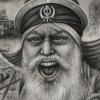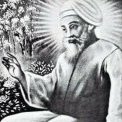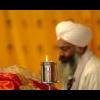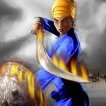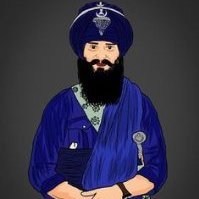Leaderboard
Popular Content
Showing content with the highest reputation on 09/23/2020 in all areas
-
I was blessed with a baby son a couple of weeks ago and gave him a nice desi name, it's also the name of a historical Sikh figure. My wife has been going to midwife appointments and she has seen the majority of apne our age (30s) have given their kids western names like Cameron, Jayden, Jordan, Kieran, Sienna, Tiana, Harvey, Cara, Kai, Keira, Emelia, Antonio. My former next door neighbours and my current neighbours have also done this and they both have khande logos on their cars. It's pathetic! Talk about being confused! What is the logic? I understand that the apne who grew up in the 60s and 70s had English nicknames as the goreh couldn't pronounce them but it's 2020 and they can now pronounce them. You will always be a brown Indian, you can never escape that no matter what you call yourself. Even worse is that some are giving their kids muslim sounding names like Armaan and Anaya. We really are a pathetic kaum. Sure it's good to take good aspects of Western culture but you should always keep your name! The goreh were in Punjab for 100 years but I never saw one of them named Balwinder Smith! This has been a big shock to me and I wonder what the future holds for us.4 points
-
Congratulations bro Yeah iv got a Simon and Jason in my family too! And a few others that I can't remember now Just another step in forgetting who you are and your ancestors and assimilating into the local culture. It's why it's so important to teach your kids Punjabi. Language keeps you tied to your culture and ancestors. Punjabis are fast becoming like the local people, without any identity, and at a very fast rate too. Theres going to be a lot of changes in the coming years. Best thing to do is keep close to your sangat as much as you can and raise your kids with sangat. Future not looking good ...4 points
-
These types of names chosen are by the brown/blond highlight haired and blue eye contact lense brigade. It's brown chavness. Bit of a strange phenomenon really. When racism was rife, people chose traditional names but now they choose names so that their kids peers can remember them. Weird! A lot of times you see these kids, the names don't suit them. I understand people don't like long names because they tend to get shortened. So they will try to pick shorter names. People will think they are getting "unique" names so that they think they are standing out but like sheep they follow the crowd. I understand people get fed up of all the -suffixed names with endings like: -inder, -deep, -jit, -bir, -dev, -pal etc. However, I think there is going to come a period when calling your kid Baldeep is going to be a breath of fresh air.2 points
-
it's a good panthic forum. pro dasam granth pro sarbloh granth2 points
-
You could still run sikhsangat but have a person from the younger generation as well running it. That way you have control as well and make sure it still runs as well.2 points
-
General Hari Singh Nalwa -19th century’s outstanding soldier, builder and diplomat Culture, News September 6, 2020September 6, 2020 indica ShareTweet By Sonia Dhami, a trustee at The Sikh Foundation International based in Palo Alto, California. General Hari Singh Nalwa’s (Above photo)successful military campaigns have literally established the current borders of modern Pakistan, Afghanistan, and India. At the beginning of the 19th century, both Kashmir and Khyber Pakhtunkwha were under Afghan rule. The Sikhs succeeded in wresting control of these territories from the formidable Afghans and established their rule. This passed on to the British till Partition in 1947, creating the nation-states of India and Pakistan. Preparation for this outcome was set in motion on the day of Baisakhi in 1801. Ten-year-old Hari from Gujranwala partook kande-di-pahul (the ceremony of initiation) and joined the fold of the Khalsa of Guru Gobind Singh. He was now transformed into Hari Singh. In Lahore, on the same day of 13th April 1801, the 21-year-old Ranjit Singh was anointed “Maharaja of Punjab”. Jamrud Fort 1930, Khanuja Family Collection. Together, Maharaja Ranjit Singh & his valiant general Sardar Hari Singh Nalwa, would create the first indigenous empire in the Punjab which would effectively stop the foreign invasions from the west, into the Indian subcontinent, which had continued unchecked for 800 years. Invaders had long poured into the Indian heartland through the Khyber Pass. Hordes traveled through Punjab to Delhi and beyond. Repeated attacks first from the Persians under Nadir Shah and later from the Afghan Durranis, continued to weaken the declining Mughal empire. A popular saying in 18th century Punjab was “Khaadha peeta laahey da baaki Ahmad Shahe da” (which means only what you eat and drink is yours the rest belongs to Ahmad Shah) aptly summed up the hegemony these foreign invaders enjoyed. In the 18th century, Sikhs were widely persecuted under Mughal rule. They literally carried a price on their heads. Overcoming the challenges, the community regrouped and gained strength by organizing itself into 12 confederacies known as misals, each controlling independent territory. As the booty laden invaders returned home, the Sikhs would attack and harass them. By the end of the 18th century, history turned a page. Through sheer grit, perseverance and faith the Sikhs turned from being the oppressed themselves to protectors fighting for the weak. Stamp with the painting of Hari Singh Nalwa. At the beginning of the 19th century, a sovereign kingdom of the Sikhs emerged under Maharaja Ranjit Singh. Expanding over the next decades, its territories at its zenith extended to the Khyber Pass in the northwest, to Kashmir, Ladakh & Mandi in the northeast, uptil Sindh & Rajputana in the south and the Sulaiman range in the west. Hari Singh joined the service of Maharaja Ranjit Singh at the young age of fourteen years. Rising rapidly in the ranks he saw action in Kasur & Multan excelling in the battlefield against the Afghans on these fronts. In 1821, General Hari Singh Nalwa was made the Governor of Kashmir and later of Peshawar and Hazara. He was born in 1791 in Gujranwala. It is not clear as to how he came to be known by the cognomen of “Nalwa” though he never officially used it. He is known to have recounted the story when he killed a tiger with his bare hands, to the Austrian traveler Baron von Hugel (1795-1870) author of “Travels in Kashmir and the Punjab” published in 1840. His grandfather joined the Khalsa confederacy of the Sukerchakia misal. His father Gurdas Singh died fighting the Afghans when Hari Singh was only 7yrs old. His mother, Dharam Kaur ensured he was educated in both Persian and Gurmukhi. Perhaps this influenced his belief in encouraging the education of girls. Endeavoring to be a “sant-sipahi” (saint soldier) he also became skilled in horse riding, swordsmanship and the art of warfare. Over the course of his lifetime, he took part in almost a dozen major battles including Kasur(1807), Sialkot (1808), Attock(1813), Multan(1818), Mankera(1822), Nowshera(1823), Sirikot (1824) and Jamrud (1837). Nineteenth-century poets like Qadir Baksh( Kadaryar), Hari Chand & Ram Dayal have eulogized him making his life a popular theme for martial ballads even today. Hari Singh Nalwa’s many military achievements have overshadowed his multiple talents. With astute diplomacy, intellect, vision, and compassion he turned victory in battle into sustaining success. As Governor of Peshawar and Hazara he paid attention to the economic development of the region under him. He established a mint of the Lahore Darbar to facilitate revenue collection in Kashmir and Peshawar. Coin issued by General Hari Singh Nalwa, Classical Numismatic Group, Inc. In 1822, he built the fortified town of Haripur, the only planned town in the 19th century in the region. He settled Khatri traders and developed it into a major trade center. He introduced citrus farming in the region and supported it by laying out a canal system to feed the villages surrounding Haripur. Named the Rangila canal it was subsequently developed, further by the British. Caring for the needs of all religious groups he built a temple, gurudwara and mosque in the town. Hari Singh was also a prolific builder. He built 26 forts to safeguard the region including the Harkishengarh fort near Haripur & the Bala Hissar fort at Peshawar. He also laid the foundation of the Fatehgarh fort at Jamrud. Some 56 buildings including forts, towers, samadhs, bungas, dharamsalas, havelis, temples, mosques, gurudwaras, tanks and gardens are credited to him. In his hometown of Gujranwala, he oversaw the construction of an impressive samadh (funerary monument) of Sardar Maha Singh, father of Maharaja Ranjit Singh. He also constructed another residence for his family, which is a fine example of Sikh architecture. His haveli in the Katas Raj temple complex, served as his base as he ventured into Khyber Pakhtunkhwa to take on Afghan raiders and secure new borders. A devout Sikh he upheld the Khalsa code of conduct and also contributed the gold for the gilding of the dome of the Akal Takhat in the Golden Temple complex. A number of shrines commemorating the Sikh Gurus including Gurudwara Panja Sahib at Hasan Abdal were built under him. He gave generously to all places of worship be it Sikh, Hindu and Muslim. An astute and vigilant general, he was always wary of the British. Maharaja Ranjit Singh chose General Hari Singh Nalwa to lead a diplomatic mission of the Lahore Darbar to meet Governor General William Bentinck at Shimla. This paved the way for the Anglo-Sikh treaty of 1831 signed on the banks for the Sutlej River in Ropar Punjab. Battle-hardened in almost a dozen major battles; he fought his final battle in Jamrud, against the Afghan pathan forces of Dost Mohammed Khan. Fatally wounded he insisted that the news of his death not be announced till reinforcements had arrived. Hari Singh Nalwa, 1830’s, Khanuja Family Collection He died, aged 46 years, and was cremated on 30th April 1837 in the Jamrud Fort. A memorial was built in 1892 by Babu Gajju Mall, a prominent Hindu resident of Peshawar. After Hari Singh Nalwa’s death, no further conquests were made and the Khyber continued to be the Sikh frontier uptil the annexation of Punjab by the British in 1849.1 point
-
Socrates used to think slavery was perfectly normal. Not exactly the most enlightened person was he? Eastern philosophers like Confuscious and Buddha were much better.1 point
-
1 point
-
100%. A lot of the names themselves sound pure chavvy as well - Jayden, Harvey, Tiana, Sienna. I don't feel like associating with such parents. There are plenty of short desi names that are easy to pronounce, I've chosen such a name. In fact I was worried that the name we chose might be too common but my wife has said his class will be full of Jaydens, Jordans, Camerons not Amars, Arjuns, Harmans! So giving your kid a western name is going to be very far from being unique.1 point
-
1 point
-
Thanks a lot veer ji for sharing this. I am amazed to know how you were doing mool mantar from 10 pm to 6 am and sleeping once every 3 days.. Spiritual Experiences were a daily thing.. WOW.. We all need this kind of Guru's Kirpa Waheguru Mehar Karey1 point
-
1 point
-
This would be correct if the word was broken up ਸਦ+ਰਸ (which it can be, but usually you would find it written seperately as ਸਦ ਰਸ rather than ਸਦਰਸ) But in Katha, and from what I have heard from Giani Singhs, the way the word is pronounced in this context is ਸ+ਦਰਸ/ਸ-ਦਰਸ ਸ = In this context could mean samaan (equal) ਦਰਸ=Daras i.e. vision/seeing. I.e. To be seen as equal to i.e. in Panjabi what we would say as ਤੁੱਲ or ਬਰਾਬਰ. This is echoed in the meaning by Bhai Kahn Singh Nabha - ਜੋ ਸਮਾਨ ਦਿਖਾਈ ਦੇਵੇ. - i.e. jo (that) samaan (equal) dikhaee deve (which is seen) - that which is seen as equal.1 point
-
This word comes up in Mahan Kosh as ਸਦ੍ਰਿਸ. It means 'equal to'. In sanskrit it is सदृश (sadarsh). As written in Mahan Kosh: ਸੰ. सदृश ਵਿ- ਸਦ੍ਰਿਕ੍ਸ਼੍. ਜੋ ਸਮਾਨ ਦਿਖਾਈ ਦੇਵੇ. ਜੇਹਾ. ਤੁੱਲ. ਸਮਾਨ. "ਕੂਰ ਕੁਪੱਤਾ ਸਦ੍ਰਿਸ ਕੁੱਤਾ". (ਗੁਪ੍ਰਸੂ). To illustrate the meaning given in Faridkot Teeka by Singhstah above: ਅਠਸਠਿ ਤੀਰਥ ਸਗਲ ਪੁੰਨ ਜੀਅ ਦਇਆ ਪਰਵਾਨੁ ॥ ਅਠਾਹਠਂ ਤੀਰਥੋਂ ਕੇ ਇਸਨਾਨ ਅਰ ਸਭ ਪੁੰਨੋਂ ਕੇ (ਪਰਵਾਨੁ) ਸਦਰਸ ਹੈ ਜੋ ਜੀਵੋਂ ਪਰ ਵਾ ਆਪਨੇ ਜੀਵ ਪਰ ਦਯਾ ਕਰਨੀ ਹੈ॥ Having daya (mercy) on all Jeev (souls) is Sadaras (equal to) all the merits/ bathing in the Athaahat Teerath (i.e. the belief that high merit was obtained in bathing in the teeraths, Guru Ji says this is truly obtained when practicing daya/mercy on all). ਆਪੇ ਕਰੇ ਕਰਾਏ ਕਰਤਾ ਅਵਰੁ ਨ ਦੂਜਾ ਤੁਝੈ ਸਰੇ ॥੯॥ (Ang 552) ਕਰਤਾ ਪੁਰਖੁ ਸਭ ਕੁਛ ਆਪ ਹੀ ਕਰਤਾ ਕਰਾਉਤਾ ਹੈ ਔਰ ਦੂਸਰਾ ਕੋਈ (ਸਰੇ) ਸਮਾਨ (ਤੁਝੈ) ਤਿਸ ਕੇ ਨਹੀਂ ਹੈ ਵਾ ਹੇ ਕਰਤਾ ਤੂੰ ਸਭ ਕਛੁ ਆਪ ਹੈਂ (ਤੁਝੇ) ਤੇਰੇ ਸਦਰਸ ਹੋਰੁ ਕੋਈ ਨਹੀਂ ਹੈ ਇਸੀ ਤ੍ਰਹ ਸੇ ਸਭ ਪਦ ਸਨਮੁਖ ਲਗਤੇ ਹੈਂ॥੯॥ Just translating this part: ਤੇਰੇ ਸਦਰਸ ਹੋਰੁ ਕੋਈ ਨਹੀਂ ਹੈ Tere (to you) Sadaras (equal) Hor Koee Nahi Hai (no one else is) i.e. no one is equal to you (Vaheguru)1 point
-
Keep control of the forum Admin ji. But maybe you can give some younger ones admin duties1 point
-
1 point
-
Welcome back. Pls, before you hand it over to someone else, can you remove me from the restriction you’ve imposed upon me? It would be nice to be free of it. I know I am not a regulator poster here but it would be good to be free, especially now that I am stranded here due to COVID travel restrictions and have no Sikh brothers or sisters to talk to. My hormones were playing up and causing a lot of aggressive behaviour in the past but now they have settled and I have grown up since then. Thank you.1 point
-
Ever so sorry to hear about your illness. Some people still don’t realise how serious this virus can be, you still see many people not wearing masks or adhering to 2 meters distancing. It is not nice to get sick but they don’t care. I am very happy to learn you are safe and sound and back. Still take care and follow the instructions to keep yourself safe and protected. Welcome back. You are totally correct, until something as serious and life threatening as this happens to a loved one people regard it as nothing to worry about and ignore its implications. There are some that think it is a big hoax. Anyway, good to know you have recovered and back. Take care.1 point
-
Agreed with Kaur , all you need is younger admin to deal with day to day side of running the site1 point
-
1 point
-
Don't worry everyones gnna be friends again when Sikhs will be doing langar sewa in London at the next protests against India's treatment of the Kashmiris.1 point
-
Brother Singh 375, Your going is a pity. One needs not to be full time at one place, you can spend half an hour here if you want as leisure or hobby. Of course there are 1 or 2 nasty people as much here, but the rest are all good fellas. Your posts are quite inspiring for all of us as they are out of personal experiences. Do not let the stupids or bully and negative affect you in any way, it only shows the low class they are. These stupid type ones have always been and will continue being here and there, so just ignore them, no matter how much they may try to act stupidly and provoke you. On the brighter side, see that 98% of the members like and enjoy your posts. Please do share your knowledge with us once in a while, it will be much appreciated. Stay blessed.1 point
-
Thank you so so much. Your posts have really helped me. Hopefully I’ll have the opportunity to talk with you again. Stay safe. Waheguru Ji Ka Khalsa, Waheguru Ji Ki Fateh ??1 point
-
Waheguru ji ka khalsa Waheeguru ji ki fateh Social media can be a real distraction and addiction toward its usage does hurt us in a very bad way. Wishing you a chardikala future ahead. Waheguru ji ka khalsa Waheeguru ji ki fateh1 point
-
EPISODE DESCRIPTION Singh Sahib Giani Mal Singh Ji (Head Granthi Sri Derbar Sahib) discuss the importance of teaching Gurmat to young children from home. It is important that parents practice and preach Sikhi to their children from home and dont depend on Parchaariks at the Gurdwara Sahib. https://www.podomatic.com/podcasts/harkeekatha81878/episodes/2013-04-05T01_13_15-07_001 point
-
BHforce do you know who the giani talking in the Video is? He is Giani Gurvinder Singh Ji Nangli Wale, a fully fledged Nihang Singh respected by all vidhvans of Budha Dal and Tarna Dal. they themselves run a Gurmat Vidhyala under Panth Akali Tarna Dal Baba Bakala. The recent Budha Dal Sarabloh Granth Sahib Paath Bodh was conducted by Giani Gurvinder Singh Ji, Giani Ji is a great vidhvaan who has studied aadh, dasam, sarabloh, vedant, Sanskrit and Farsi in depth. The old Budha Dal Gutka has many typo mistakes as it was printed by Chattar Jeevan Singh Amritsar rather than Budha Dal directly. You can ask many Budha Dal Singhs they recite the extra line in Braham kavach as Giani Ji has stated.1 point
-
-1 points
-
-1 points
-
-1 points
-
No idea bro, but there seems to be a lot of beheading in their ithiaas!-1 points


